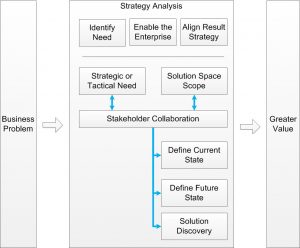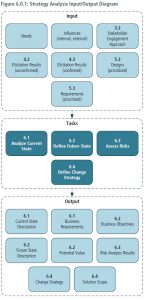The Business Analysis Core Concept Model™ (BACCM™) describes the relationships among the six core concepts. The following table describes the usage and application of each of the core concepts within the context of Strategy Analysis.
Table 6.0.1: The Core Concept Model in Strategy Analysis
| Core Concept | During Business Analysis Planning and Monitoring, business analysts… |
| Change: the act of transformation in response to a need. | define the future state and develop a change strategy to achieve the future state. |
| Need: a problem or opportunity to be addressed. | identify needs within the current state and prioritize needs to determine the desired future state. |
| Solution: a specific way of satisfying one or more needs in a context. | define the scope of a solution as part of developing a change strategy. |
| Stakeholder: a group or individual with a relationship to the change, the need, or the solution. | collaborate with stakeholders to understand the business need and to develop a change strategy and future state that will meet those needs. |
| Value: the worth, importance, or usefulness of something to a stakeholder within a context. | examine the potential value of the solution to determine if a change is justified. |
| Context: the circumstances that influence, are influenced by, and provide understanding of the change. | consider the context of the enterprise in developing a change strategy. |


The Strategy Analysis knowledge area includes the following tasks:
- Analyze Current State: understands the business need and how it relates to the way the enterprise functions today. Sets a baseline and context for change.
- Define Future State: defines goals and objectives that will demonstrate that the business need has been satisfied and defines what parts of the enterprise need to change in order to meet those goals and objectives.
- Assess Risks: understands the uncertainties around the change, considers the effect those uncertainties may have on the ability to deliver value through a change, and recommends actions to address risks where appropriate.
- Define Change Strategy: performs a gap analysis between current and future state, assesses options for achieving the future state, and recommends the highest value approach for reaching the future state including any transition states that may be required along the way.
Chapter 6: Strategy Analysis pg. 103
